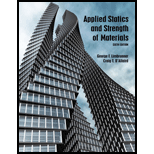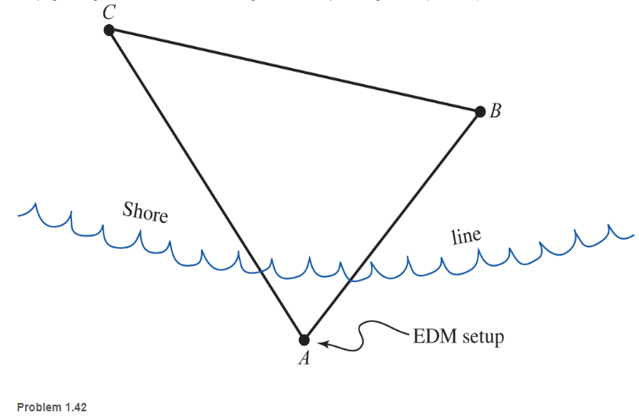
Applied Statics and Strength of Materials (6th Edition)
6th Edition
ISBN: 9780133840544
Author: George F. Limbrunner, Craig D'Allaird, Leonard Spiegel
Publisher: PEARSON
expand_more
expand_more
format_list_bulleted
Textbook Question
Chapter 1, Problem 1.42SP
An electronic distance measurement device (EDM) is to be used to lay out a canoe race course on a lake Buoys Band C have been placed The EDM is set up at point A as shown AB is 175.83 m and AC is 287.21 m The angle at A is 42°37’20”.
a. Find the length CB.
b. Keeping the angle at A and the line AB unchanged, find the required length of AC (to 0.01 m) so that BC is 200.00 m.

Expert Solution & Answer
Want to see the full answer?
Check out a sample textbook solution
Students have asked these similar questions
(read image)
(read image)
(read me)
Chapter 1 Solutions
Applied Statics and Strength of Materials (6th Edition)
Ch. 1 - Prob. 1.1PCh. 1 - In the right triangle ABC shown, c = 25 ft and...Ch. 1 - Determine the length of side a and the meausre of...Ch. 1 - A 28-ft-long ladder leaning against a wall makes...Ch. 1 - Two legs of a right triangle are 6 ft and 10 ft....Ch. 1 - In the roof truss shown determine the lengths of...Ch. 1 - A level scaffold s to be supported at the center...Ch. 1 - A wanderer hikes due east for 2 mi, then southeast...Ch. 1 - Freehand sketch the following triangles and solve...Ch. 1 - One side of a triangular lot is 100 ft and the...
Ch. 1 - A box containing 8 shock absorbers and 10 brake...Ch. 1 - Prob. 1.12PCh. 1 - Express 0.015 ton (a) in pounds (lb) and (b) in...Ch. 1 - Express 5 mi (a) in yards (yd) and (b) in feet...Ch. 1 - Express 60 miles per hour (mph) in units of feet...Ch. 1 - Find the number of square rods in one acre.Ch. 1 - A reservoir contains an estimated 125 billion...Ch. 1 - Convert the following: a. 27 ft 734 in. to...Ch. 1 - 1.19 A water system of 2 in (inside diameter)...Ch. 1 - The soil pressure under a concrete footing is...Ch. 1 - Using Table 1 , establish your height in...Ch. 1 - The dimensions on a baseball field are as follows:...Ch. 1 - Convert the following quantities from U.S....Ch. 1 - Convert the following quantities to SI units of...Ch. 1 - Convert the following quantities to SI units of...Ch. 1 - Convert the following quantities to the designated...Ch. 1 - 1.27 Rework Problem 1.19 using an inside pipe...Ch. 1 - A spherical tank has a radius of 27 in. Find the...Ch. 1 - 1.29 A ladder rests against a vertical wall at a...Ch. 1 - A surveyor measures a zenith angle of 70° 03’20”...Ch. 1 - The tower of a tower crane casts a shadow (on...Ch. 1 - 1.32 From the top of a 30-ft building, the angle...Ch. 1 - Two planes, starting from airport X, fly for 2 hr,...Ch. 1 - Rework Problem 1.31 assuming that the ground...Ch. 1 - An Egyptian pyramid has a square base and...Ch. 1 - Two observation towers A and B are located 300 ft...Ch. 1 - Two people fishing from rowboats on a lake are 100...Ch. 1 - What is the average speed in miles per hour (mph)...Ch. 1 - The volume flow of a river is expressed as 5000...Ch. 1 - A 55-gal drum filled with sand weighs 816 lb. The...Ch. 1 - The total area to be occupied by a building and a...Ch. 1 - An electronic distance measurement device (EDM) is...
Knowledge Booster
Learn more about
Need a deep-dive on the concept behind this application? Look no further. Learn more about this topic, mechanical-engineering and related others by exploring similar questions and additional content below.Similar questions
- (read me)arrow_forward(read image)arrow_forwardQu. 13 What are the indices for the Direction 2 indicated by vector in the following sketch? Qu. 14 Determine the indices for the direction A and B shown in the following cubic unit cell. please show all work step by step from material engineeringarrow_forward
- The thin-walled open cross section shown is transmitting torque 7. The angle of twist ₁ per unit length of each leg can be determined separately using the equation 01 = 3Ti GLIC 3 where G is the shear modulus, ₁ is the angle of twist per unit length, T is torque, and L is the length of the median line. In this case, i = 1, 2, 3, and T; represents the torque in leg i. Assuming that the angle of twist per unit length for each leg is the same, show that T= Lic³ and Tmaz = G01 Cmax Consider a steel section with Tallow = 12.40 kpsi. C1 2 mm L1 20 mm C2 3 mm L2 30 mm C3 2 mm L3 25 mm Determine the torque transmitted by each leg and the torque transmitted by the entire section. The torque transmitted by the first leg is | N-m. The torque transmitted by the second leg is N-m. The torque transmitted by the third leg is N-m. The torque transmitted by the entire section is N-m.arrow_forwardPlease help, make sure it's to box out and make it clear what answers go where...arrow_forwardThe cylinder floats in the water and oil to the level shown. Determine the weight of the cylinder. (rho)o=910 kg/m^3arrow_forward
arrow_back_ios
SEE MORE QUESTIONS
arrow_forward_ios
Recommended textbooks for you
 International Edition---engineering Mechanics: St...Mechanical EngineeringISBN:9781305501607Author:Andrew Pytel And Jaan KiusalaasPublisher:CENGAGE L
International Edition---engineering Mechanics: St...Mechanical EngineeringISBN:9781305501607Author:Andrew Pytel And Jaan KiusalaasPublisher:CENGAGE L Precision Machining Technology (MindTap Course Li...Mechanical EngineeringISBN:9781285444543Author:Peter J. Hoffman, Eric S. Hopewell, Brian JanesPublisher:Cengage Learning
Precision Machining Technology (MindTap Course Li...Mechanical EngineeringISBN:9781285444543Author:Peter J. Hoffman, Eric S. Hopewell, Brian JanesPublisher:Cengage Learning

International Edition---engineering Mechanics: St...
Mechanical Engineering
ISBN:9781305501607
Author:Andrew Pytel And Jaan Kiusalaas
Publisher:CENGAGE L

Precision Machining Technology (MindTap Course Li...
Mechanical Engineering
ISBN:9781285444543
Author:Peter J. Hoffman, Eric S. Hopewell, Brian Janes
Publisher:Cengage Learning
Relationship Between Elastic Constants and Connecting Equations; Author: Engineers Academy;https://www.youtube.com/watch?v=whW5PnM7Pug;License: Standard Youtube License